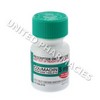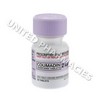Customers also like
Xarelto (Rivaroxaban) - 10mg (10 Tablets)
from only £20.78
Xarelto (Rivaroxaban) - 20mg (28 Tablets)
from only £59.10
Coumadin (Warfarin Sodium) - 5mg (50 Tablets)
from only £3.39
Coumadin (Warfarin Sodium) - 2mg (50 Tablets)
from only £8.48
Plavix 75 (Clopidogrel Bisulfate) - 75mg (14 Tablets)
from only £11.99
Pletoz (Cilostazol) - 100mg (10 Tablets)
from only £7.17
Description
| Main Use | Active Ingredient | Marketed Name |
| Treatment for blood clots | Rivaroxaban | Xarelto |
Uses
Xarelto (Rivaroxaban) is indicated for the treatment of deep vein thrombosis and pulmonary embolism. It has also been administered to patients affected by nonvalvular atrial fibrillation, so as to reduce the risk of stroke. This anti-thrombotic medicine works by preventing blood clots forming inside the body's blood vessels. Usually, blood clots are formed when the body is cut or injured, to prevent further bleeding. Many different chemicals contribute to this complicated process.
One of these is an enzyme called thrombin. It is required to form a blood clot, as it triggers the conversion of fibrinogen into fibrin. Following this, fibrin helps the blood platelets to clump together and form a blood clot. However, this medicine blocks the formation of thrombin, which in turn helps stop fibrin (which is needed for the blood to clot) from being formed. This helps to treat dangerous blood clots that may have formed in the leg or lungs, and may prevent dangerous health complications which may arise from this.
Dosage and Administration
Xarelto (Rivaroxaban) tablets contain 15mg of the active ingredient and are taken by mouth. The dosage will vary for each patient, depending on what condition is being treated. Patients affected by nonvalvular atrial fibrillation whose creatinine clearance (CrCl) ranges from 15ml to 50ml per min and who are being given this medicine to reduce the risk of a stroke may be told to take 1 tablet (15mg) per day, administered alongside their evening meal.
Adults affected by deep vein thrombosis or pulmonary embolism may be instructed to begin with 15mg taken twice per day for a period of 21 days, after which the doctor may reduce the dosage to 20mg, taken once per day for the remainder of treatment. They will also need to take it with food. Patients should note that the dosage for other conditions may be different, and your doctor may recommend a different strength of medicine or alternative dosage regimen.
Side effects
It is important to be aware of the fact that Xarelto (Rivaroxaban) might cause some side effects, which could include:
- Itchiness
- Headache
- Spinning sensation
- Painful legs or arms
- Soreness affecting the muscles
Other side effects are also possible. You will require immediate medical attention if you suffer from nosebleeds, bleeding from the gums or elsewhere in the body, red or otherwise discoloured urine, fatigue, feeling weak or any other serious side effects that are not listed here.
Precautions
Abruptly stopping treatment may put you at an increased risk of suffering from a stroke. It may also make the occurrence of a blood clot more likely. Discuss this with your doctor before starting treatment.
Inform any doctor, dentist or other medical professional who treats you that you are taking this medicine, especially if you are scheduled to undergo surgery or any dental procedures.
Seek immediate emergency medical attention if you suffer an allergic reaction. Symptoms to watch for, which may be indicative of a reaction, include skin rashes, hives, swelling of the face or limbs, trouble breathing, and trouble swallowing.
Always use Xarelto (Rivaroxaban) as you have been prescribed by your doctor. Never self-medicate or change your dosage without first consulting your doctor. The correct dosage can vary depending on your health, medical history, and the severity of the condition being treated.
This medication may not be safe for all patients. Before you begin using it always disclose the following to your doctor:
- If you are pregnant or breastfeeding.
- If you suffer from any allergies.
- If you suffer from any other health conditions or illnesses.
- If you are using any other medicine (including all non-prescription).
- If you are using any supplements, vitamins, or herbal products of any kind.


-Tab-15mg-UK-1.jpg)
-Tab-10mg-UK-1s.jpg)
-Tab-20mg-UK-1s.jpg)


-14Tabs-75mg-UK-1s.jpg)
-Tab-100mg-UK-1s.jpg)
-Tab-15mg-UK-1s.jpg)


